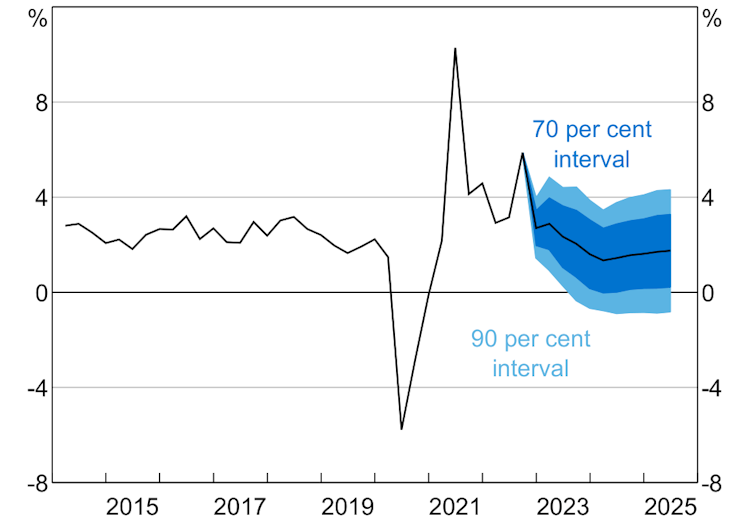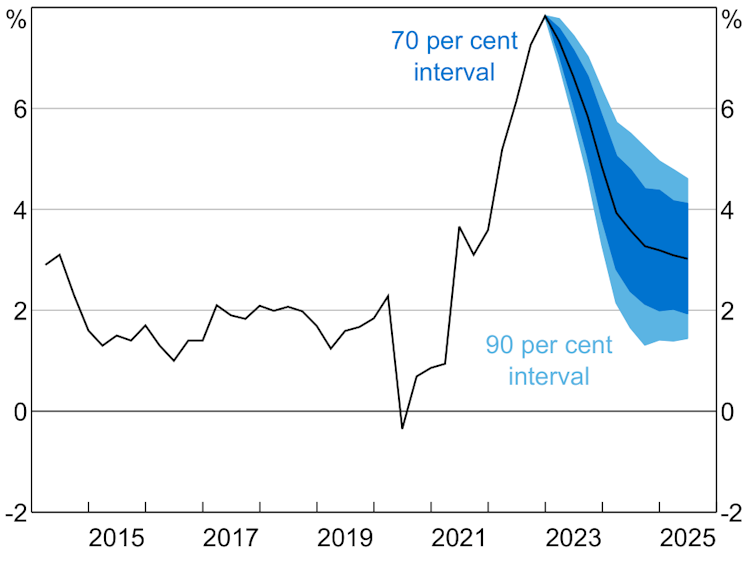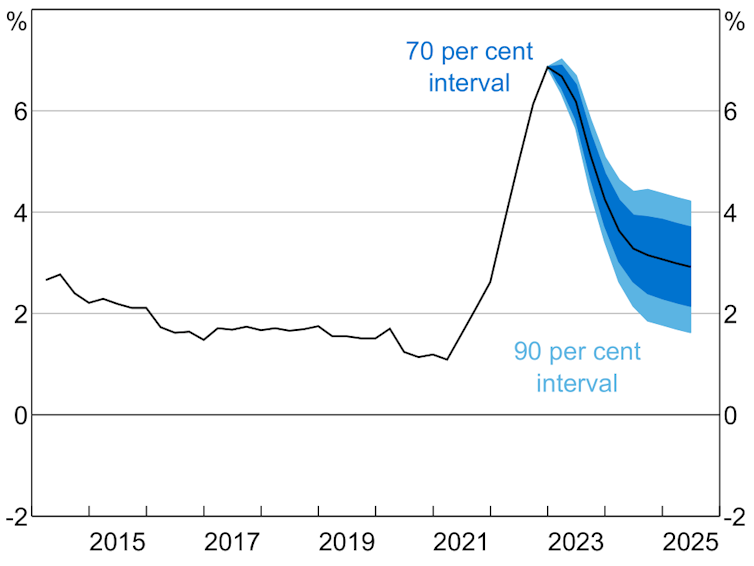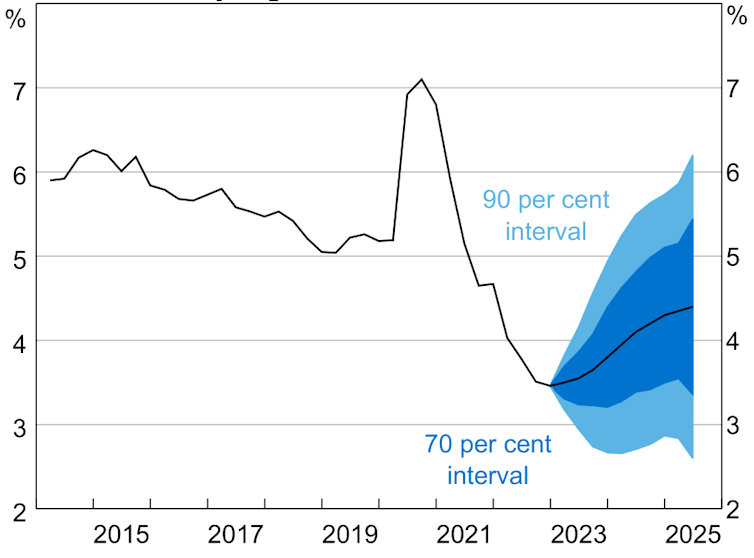After lifting interest rates for a record nine times in a row, and flagging more raises still to come, the Reserve Bank of Australia’s latest set of forecasts make for grim reading.
The forecasts are part of the central bank’s quarterly Statement on Monetary Policy, its main communication (aside from interest rates) on how it sees the economy faring over coming few years.
The bad news is the bank tips economic growth to slow, inflation to remain high, spending to stagnate, unemployment to increase, and real wages to fall further.
The good news is that it could be wrong.
1. Growth is expected to slow
The central bank expects Australia’s economy to slow this year due to rising interest rates, higher cost of living, and declining house prices. It tips GDP growth for 2022 will be 2.75% (the Australian Bureau of Statistics won’t publish this data until March), and 1.5% over 2023 and 2024. This compares to the RBA’s expectation three months ago of 3% growth in 2022 but the same prediction for this year and the next.
RBA GDP growth forecasts
Confidence intervals reflect RBA forecast errors since 1993, year-ended forecasts. RBA
2. Inflation will remain high
The bank says inflation, which hit 7.8% in 2022, is likely to have peaked and predicts it will stay high for several months, but will decline to 4.5% by the end of 2023. By mid-2025 it should be back to 3% – the top end of the bank’s inflation target range of 2-3%.
RBA headline inflation forecasts
Confidence intervals reflect RBA forecasting errors since 1993. Year-end forecasts. RBA
However, the pace of this fall depends on wages and prices. The central bank acknowledges it could be quicker or slower. Its outlook for household spending is also uncertain, due to factors such as rising interest rates, higher inflation and declining housing prices.
Australia’s consumer price inflation has been high due to factors including global supply-chain disruptions caused by the pandemic, Russia’s invasion of Ukraine, strong domestic demand, a tight labour market, and capacity constraints.
The RBA expects rising energy prices will continue to drive inflation but that this will be offset by the federal government’s Energy Price Relief Plan, which involves price caps on gas and coal, and bill subsidies for households and businesses.
Price increases for goods such as food and furniture are expected to moderate. But the cost of services will continue to rise, due to wage growth.
RBA inflation forecasts
Confidence intervals reflect RBA forecasting errors since 1993. Year-end forecasts. RBA
This is the main reason the RBA has flagged more interest rate hikes this year. It is determined to get inflation back to its target band, and will keep increasing borrowing rates until it is sure this goal will be achieved.
3. Household consumption will stagnate
The monetary policy statement expects higher consumer prices, higher interest payments and lower household net wealth to curb consumer spending in 2023.
But it expects spending to improve once interest rate rises stop, household wealth recovers and disposable incomes are boosted by tax cuts. The household saving ratio (which doubled during the pandemic) is expected to decline then increase, returning to pre-pandemic levels in 2024.
4. Unemployment will rise
The RBA expects the unemployment rate to remain at about 3.5% until mid-2023, and then to rise to 4.5% as demand for labour moderates.
RBA unemployment rate forecasts
Confidence intervals reflect RBA forecasting errors since 1993. RBA
Jobs growth is forecast to slow from 4.8% in 2022 to about 1% by mid-2024. Despite this, the participation rate in the labour force is not expected to fall, due to structural trends such as higher female and older worker participation.
5. Real wages will still fall
The RBA’s forecast for wages growth is now higher than three months ago, due to a tight labour market, higher staff turnover, higher inflation outcomes and Fair Work Commission wage decisions. It tips the Wage Price Index (WPI), which hasn’t been above 4% in a decade, to hit 4.25% in late 2023.
Given the inflation rate, however, this won’t be enough to stop real wages from continuing to fall. The WPI is then tipped to decline to 3.75% in mid-2025 as the demand for labour subsides and the unemployment rate rises.
Uncertainty remains high
These forecasts make for grim reading. But they could all be quite wrong.
As the saying goes, it’s tough to make predictions, especially about the future. Huge uncertainties hang over the global economy, including the war in Ukraine, the emergence of new COVID variants, and the unique challenges of recovering from the pandemic.
That means all these forecasts could be – and likely will be – wrong in one dimension or another. Even the RBA governor’s very clear message that there will be more interest rate rises this year could change if the prevailing circumstances do too. Only time will tell.



 Gold and Silver Prices Dip as Markets Await Key U.S. Economic Data
Gold and Silver Prices Dip as Markets Await Key U.S. Economic Data  New Zealand Budget Outlook Shows Prolonged Deficits Despite Economic Recovery Hopes
New Zealand Budget Outlook Shows Prolonged Deficits Despite Economic Recovery Hopes  Asian Currencies Slip as Dollar Strengthens; Indian Rupee Rebounds on Intervention Hopes
Asian Currencies Slip as Dollar Strengthens; Indian Rupee Rebounds on Intervention Hopes  Brazil Holds Selic Rate at 15% as Inflation Expectations Stay Elevated
Brazil Holds Selic Rate at 15% as Inflation Expectations Stay Elevated  BOJ Faces Pressure for Clarity, but Neutral Rate Estimates Likely to Stay Vague
BOJ Faces Pressure for Clarity, but Neutral Rate Estimates Likely to Stay Vague  Asian Stocks Edge Higher as Tech Recovers, U.S. Economic Uncertainty Caps Gains
Asian Stocks Edge Higher as Tech Recovers, U.S. Economic Uncertainty Caps Gains  Japan’s Finance Minister Signals Alignment With BOJ as Rate Hike Speculation Grows
Japan’s Finance Minister Signals Alignment With BOJ as Rate Hike Speculation Grows  Chinese Robotaxi Stocks Rally as Tesla Boosts Autonomous Driving Optimism
Chinese Robotaxi Stocks Rally as Tesla Boosts Autonomous Driving Optimism  Bank of Korea Downplays Liquidity’s Role in Weak Won and Housing Price Surge
Bank of Korea Downplays Liquidity’s Role in Weak Won and Housing Price Surge  RBI Cuts Repo Rate to 5.25% as Inflation Cools and Growth Outlook Strengthens
RBI Cuts Repo Rate to 5.25% as Inflation Cools and Growth Outlook Strengthens  Japan PMI Data Signals Manufacturing Stabilization as Services Continue to Drive Growth
Japan PMI Data Signals Manufacturing Stabilization as Services Continue to Drive Growth  RBA Unlikely to Cut Interest Rates in 2026 as Inflation Pressures Persist, Says Westpac
RBA Unlikely to Cut Interest Rates in 2026 as Inflation Pressures Persist, Says Westpac 





































